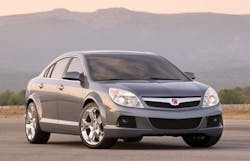AutoFocus: Don't be afraid of Saturn EGR codes
Exhaust Gas Recirculation (EGR) codes become relatively common on GM vehicles as they age. EGR codes are most often the first clue that there’s an EGR flow issue, but sometimes the complaint is related to pinging, due to improper combustion chamber cooling due to a lack of EGR.
Depending on the year or the engine in the vehicle, some of the EGR codes identified by GM include: 32, 75, 76, 77, P0400, P0401, P0404, and P1406. Some codes are unique to EGR flow while some are unique to EGR valve position. Still other codes can be caused by either a lack of EGR flow or an incorrect EGR pintle position. EGR flow is determined by the MAP/MAF or the front O2 sensor(s). The above codes may be caused by a faulty EGR valve, powertrain control module (PCM), or EGR solenoid, but are most often caused by excessive engine carbon that has built up in both the intake and the exhaust ports for the EGR system.
The following procedure is loosely based on a GM Cadillac service bulletin for engine carbon removal. Identifix has identified the speedometer cable as an excellent “scraper” tool to remove the softened carbon.
1. Remove the EGR valve. Block the intake port with a suitable plug.
2. Run the engine until operating temperature is reached.
3. Install a metal funnel in the intake EGR port.
4. Slowly pour Upper Engine Cleaner (UEC) or equivalent into the intake port. NOTE: Do not pour the cleaner into the engine too quickly as it could cause engine damage due to hydro-lock.
5. Shut the engine off when the full bottle/can has been ingested.
6. Move the funnel over to the exhaust port.
7. Pour a second bottle/can of UEC into the exhaust EGR port.
8. Let the vehicle sit for 6 to 8 hours or longer.
9. Connect a speedometer cable into a drill, cut and fray the other end of the cable.
10. Spin the cable in the EGR passages to scrape the carbon from the passages.
11. Cover the ports with a rag.
12. Start the engine, rev a couple of times, then shut off the engine.
13. Install the EGR valve and road test.
Note: This procedure is best done outside as it will generate a great deal of toxic smoke.
